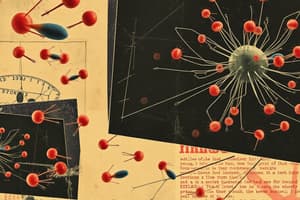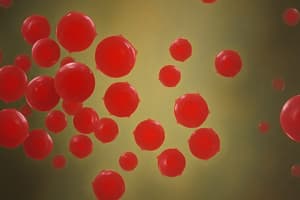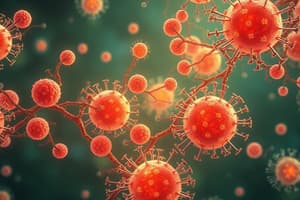Podcast
Questions and Answers
What is the size range of a segmented neutrophil?
What is the size range of a segmented neutrophil?
- 12-16 um
- 15-20 um
- 10-15 um (correct)
- 8-10 um
Which cell type makes up less than 1% of the nucleated cells in the bone marrow and 5% of peripheral WBCs?
Which cell type makes up less than 1% of the nucleated cells in the bone marrow and 5% of peripheral WBCs?
- Segmented neutrophil
- Basophil
- Eosinophil (correct)
- Lymphocyte
What is the typical nucleus shape of an eosinophil?
What is the typical nucleus shape of an eosinophil?
- Tri-lobed
- Unilobed
- Multi-lobed
- Bilobed (correct)
Which type of granules contain heparin and histamine?
Which type of granules contain heparin and histamine?
What is the N:C ratio of a neutrophil?
What is the N:C ratio of a neutrophil?
What makes up less than 0.1% of the nucleated cells in both the bone marrow and peripheral blood?
What makes up less than 0.1% of the nucleated cells in both the bone marrow and peripheral blood?
Which cell type has cytoplasm filled with small, pale blue to pink specific/secondary granules?
Which cell type has cytoplasm filled with small, pale blue to pink specific/secondary granules?
What is the characteristic feature of the nucleus of a segmented neutrophil?
What is the characteristic feature of the nucleus of a segmented neutrophil?
Which cell type makes up 12% of the nucleated cells in the bone marrow?
Which cell type makes up 12% of the nucleated cells in the bone marrow?
What is the typical size range of a basophil?
What is the typical size range of a basophil?
What is the main content of the cytoplasmic granules in an eosinophil?
What is the main content of the cytoplasmic granules in an eosinophil?
Which cell type has cytoplasm containing large, purple-black, secondary granules?
Which cell type has cytoplasm containing large, purple-black, secondary granules?
What recognizable maturation stages are present in an eosinophil?
What recognizable maturation stages are present in an eosinophil?
What is the N:C ratio of a neutrophil?
What is the N:C ratio of a neutrophil?
Which pool contains metamyelocytes, bands, and segmented neutrophils in the bone marrow?
Which pool contains metamyelocytes, bands, and segmented neutrophils in the bone marrow?
What attracts neutrophils to the site of inflammation?
What attracts neutrophils to the site of inflammation?
Which process involves neutrophil attachment to a foreign object, formation of a vacuole around it, and release of lytic enzymes?
Which process involves neutrophil attachment to a foreign object, formation of a vacuole around it, and release of lytic enzymes?
What is the fate of neutrophils when they are destroyed in the process of phagocytosis?
What is the fate of neutrophils when they are destroyed in the process of phagocytosis?
Where is the rapid and free exchange of neutrophils between different pools observed?
Where is the rapid and free exchange of neutrophils between different pools observed?
What is the main content of the cytoplasmic granules in a neutrophil?
What is the main content of the cytoplasmic granules in a neutrophil?
What type of granulocyte pool mainly contains neutrophils that adhere to vessel walls?
What type of granulocyte pool mainly contains neutrophils that adhere to vessel walls?
What releases neutrophils into circulation when they are mature or needed?
What releases neutrophils into circulation when they are mature or needed?
What do opsonins such as IgG and complement component C3b help neutrophils recognize as foreign?
What do opsonins such as IgG and complement component C3b help neutrophils recognize as foreign?
Where do neutrophils diapedese into the tissues from in response to antigenic stimulation?
Where do neutrophils diapedese into the tissues from in response to antigenic stimulation?
What is indicated by the presence of colorless areas in the cytoplasm of neutrophils?
What is indicated by the presence of colorless areas in the cytoplasm of neutrophils?
What is the most common type of left shift associated with an increased demand for neutrophils?
What is the most common type of left shift associated with an increased demand for neutrophils?
What is indicated by the presence of small oval inclusions (RNA) located in the cytoplasm of neutrophils?
What is indicated by the presence of small oval inclusions (RNA) located in the cytoplasm of neutrophils?
What is the appropriate bone marrow response to increased demand for neutrophils?
What is the appropriate bone marrow response to increased demand for neutrophils?
What is associated with an increased number of myelocytes, metamyelocytes, and/or bands in the peripheral blood?
What is associated with an increased number of myelocytes, metamyelocytes, and/or bands in the peripheral blood?
What change in neutrophils is seen after an overwhelming infection in which bone marrow production cannot keep up with increased need for neutrophils?
What change in neutrophils is seen after an overwhelming infection in which bone marrow production cannot keep up with increased need for neutrophils?
What change in neutrophils refers to prominent granulation due to persistent staining of primary granules?
What change in neutrophils refers to prominent granulation due to persistent staining of primary granules?
Which type of cell releases substances that can neutralize products released by basophils and mast cells, and also modulate the allergic response?
Which type of cell releases substances that can neutralize products released by basophils and mast cells, and also modulate the allergic response?
What initiates the classic signs of immediate hypersensitivity reactions (Type I) by releasing histamine upon degranulation?
What initiates the classic signs of immediate hypersensitivity reactions (Type I) by releasing histamine upon degranulation?
Which type of cell expresses Fc receptors for IgE in response to parasitic infections?
Which type of cell expresses Fc receptors for IgE in response to parasitic infections?
Which cell type releases a chemotactic factor that attracts eosinophils to the site of inflammation?
Which cell type releases a chemotactic factor that attracts eosinophils to the site of inflammation?
What is the cause of neutropenia due to chronic or severe infection?
What is the cause of neutropenia due to chronic or severe infection?
What is a characteristic associated with basophilia?
What is a characteristic associated with basophilia?
What can cause an increase in eosinophils?
What can cause an increase in eosinophils?
What is a potential cause of basopenia?
What is a potential cause of basopenia?
What disorder is associated with the presence of immature leukocytes and immature erythrocytes in the blood?
What disorder is associated with the presence of immature leukocytes and immature erythrocytes in the blood?
What can cause a decrease in absolute number of neutrophils?
What can cause a decrease in absolute number of neutrophils?
What is a potential cause for the decrease in the absolute number of basophils?
What is a potential cause for the decrease in the absolute number of basophils?
What can lead to an increase in the absolute number of eosinophils?
What can lead to an increase in the absolute number of eosinophils?
What can cause neutropenia due to bone marrow production defects?
What can cause neutropenia due to bone marrow production defects?
What is the main difference between physiologic pseudoneutrophilia and pathologic neutrophilia?
What is the main difference between physiologic pseudoneutrophilia and pathologic neutrophilia?
What distinguishes the neutrophilic leukemoid reaction (NLR) from chronic myelogenous leukemia?
What distinguishes the neutrophilic leukemoid reaction (NLR) from chronic myelogenous leukemia?
What differentiates physiologic pseudoneutrophilia from pathologic neutrophilia?
What differentiates physiologic pseudoneutrophilia from pathologic neutrophilia?
What is a distinguishing feature of neutrophilic leukemoid reaction (NLR) compared to physiologic pseudoneutrophilia?
What is a distinguishing feature of neutrophilic leukemoid reaction (NLR) compared to physiologic pseudoneutrophilia?
What distinguishes pathologic neutrophilia from neutrophilic leukemoid reaction (NLR)?
What distinguishes pathologic neutrophilia from neutrophilic leukemoid reaction (NLR)?
What sets physiologic pseudoneutrophilia apart from neutrophilic leukemoid reaction (NLR)?
What sets physiologic pseudoneutrophilia apart from neutrophilic leukemoid reaction (NLR)?
What differentiates the shift observed in pathologic neutrophilia from that seen in physiologic pseudoneutrophilia?
What differentiates the shift observed in pathologic neutrophilia from that seen in physiologic pseudoneutrophilia?
What is the underlying cause of chronic granulomatous disease (CGD)?
What is the underlying cause of chronic granulomatous disease (CGD)?
What is the characteristic feature of Chediak-Higashi syndrome?
What is the characteristic feature of Chediak-Higashi syndrome?
What is the main cause of hypersegmentation in neutrophils?
What is the main cause of hypersegmentation in neutrophils?
What is the morphological difference between hypersegmentation and hyposegmentation?
What is the morphological difference between hypersegmentation and hyposegmentation?
What is the main consequence of the inability of neutrophils to degranulate in CGD?
What is the main consequence of the inability of neutrophils to degranulate in CGD?
What is the genetic basis of Chediak-Higashi syndrome?
What is the genetic basis of Chediak-Higashi syndrome?
What distinguishes Pelger-Huet anomaly from hypersegmentation?
What distinguishes Pelger-Huet anomaly from hypersegmentation?
What is the main concern associated with morphologically normal but functionally abnormal leukocytes?
What is the main concern associated with morphologically normal but functionally abnormal leukocytes?
'Left shift' on blood smear is indicative of:
'Left shift' on blood smear is indicative of:
What differentiates hypersegmentation from hyposegmentation?
What differentiates hypersegmentation from hyposegmentation?
What is the characteristic associated with Chediak-Higashi syndrome?
What is the characteristic associated with Chediak-Higashi syndrome?
What is the main difference between MAY-HEGGLIN ANOMALY and ALDER-REILLY ANOMALY?
What is the main difference between MAY-HEGGLIN ANOMALY and ALDER-REILLY ANOMALY?
Which anomaly is associated with autosomal dominant inheritance?
Which anomaly is associated with autosomal dominant inheritance?
What is the characteristic feature of ALDER-REILLY ANOMALY?
What is the characteristic feature of ALDER-REILLY ANOMALY?
What distinguishes the cytoplasmic anomalies described in the text from toxic granulation present in neutrophils only in infectious conditions?
What distinguishes the cytoplasmic anomalies described in the text from toxic granulation present in neutrophils only in infectious conditions?
Which growth factors and interleukins act on the committed progenitor cell, CFU-GM, to form monocytes?
Which growth factors and interleukins act on the committed progenitor cell, CFU-GM, to form monocytes?
Where in the body do Kupffer cells primarily function?
Where in the body do Kupffer cells primarily function?
What is the name for the macrophages found in the central nervous system?
What is the name for the macrophages found in the central nervous system?
What is the characteristic feature of the transition from promonocyte to monocyte?
What is the characteristic feature of the transition from promonocyte to monocyte?
What distinguishes the macrophage from the other monocyte precursors?
What distinguishes the macrophage from the other monocyte precursors?
What is the main difference between a monoblast and a promonocyte?
What is the main difference between a monoblast and a promonocyte?
What distinguishes a monocyte from a promonocyte?
What distinguishes a monocyte from a promonocyte?
What is the most likely feature of a macrophage compared to a monoblast?
What is the most likely feature of a macrophage compared to a monoblast?
What is the distinguishing feature of a promonocyte compared to a monocyte?
What is the distinguishing feature of a promonocyte compared to a monocyte?
What is the main function of monocytes/macrophages in the immune response?
What is the main function of monocytes/macrophages in the immune response?
Which cells are known as 'scavenger cells' due to their ability to ingest foreign material?
Which cells are known as 'scavenger cells' due to their ability to ingest foreign material?
What do blood monocytes ingest, limiting the coagulation response?
What do blood monocytes ingest, limiting the coagulation response?
Which cells are very efficient phagocytic cells with receptors for IgG or complement-coated organisms?
Which cells are very efficient phagocytic cells with receptors for IgG or complement-coated organisms?
Where do splenic macrophages primarily remove old/damaged red blood cells?
Where do splenic macrophages primarily remove old/damaged red blood cells?
What do bone marrow macrophages remove and store for hemoglobin synthesis?
What do bone marrow macrophages remove and store for hemoglobin synthesis?
What do monocytes secrete, in addition to cytokines/interleukins and tumor necrosis factor?
What do monocytes secrete, in addition to cytokines/interleukins and tumor necrosis factor?
What is the primary function of liver macrophages?
What is the primary function of liver macrophages?
Flashcards are hidden until you start studying




